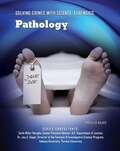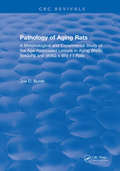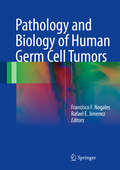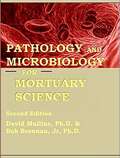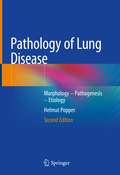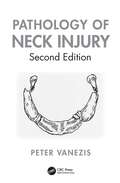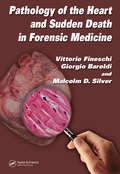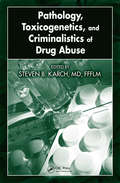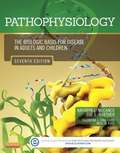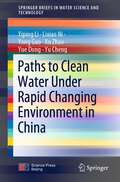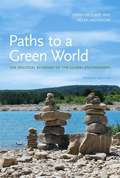- Table View
- List View
Pathologist of the Mind: Adolf Meyer and the Origins of American Psychiatry
by S. D. LambIlluminating the contributions of Adolf Meyer, the pioneering father of modern American psychiatry.Winner of the CHOICE Outstanding Academic Title of the Choice ACRLDuring the first half of the twentieth century, Adolf Meyer was the most authoritative and influential psychiatrist in the United States. In 1908, when the Johns Hopkins Hospital established the first American university clinic devoted to psychiatry—still a nascent medical specialty at the time—Meyer was selected to oversee the enterprise. The Henry Phipps Psychiatric Clinic opened in 1913, and Meyer served as psychiatrist-in-chief at Johns Hopkins until 1941. In Pathologist of the Mind, S. D. Lamb explores how Meyer used his powerful position to establish psychiatry as a clinical science that operated like the other specialties at the country’s foremost medical school and research hospital. In addition to successfully arguing for a scientific and biological approach to mental illness, Meyer held extraordinary sway over state policies regarding the certification of psychiatrists. He also trained hundreds of specialists who ultimately occupied leadership positions and made significant contributions in psychiatry, neurology, experimental psychology, social work, and public health. Although historians have long recognized Meyer’s authority, his concepts and methods have never before received a systematic historical analysis. Pathologist of the Mind aims to rediscover Meyerian psychiatry by eavesdropping on Meyer’s informal and intimate conversations with patients and colleagues. Weaving together private correspondence and uniquely detailed case histories, Lamb examines Meyer’s efforts to institute a clinical science of psychiatry in the United States—one that harmonized the expectations of scientific medicine with his concept of the person as a biological organism and mental illness as an adaptive failure. The first historian ever granted access to these exceptional medical records, Lamb offers a compelling new perspective on the integral but misunderstood legacy of Adolf Meyer.
Pathology (Solving Crimes With Science: Forensics #12)
by Maryalice Walker"Real-life" crime dramas on television intrigue us with the details of postmortem examinations leading to the arrest of murder suspects--but how do forensic pathologists, the doctors who investigate unnatural deaths and chilling crime scenes, actually bring criminals to justice? The story lies in the body of evidence. Literally. The human body provides a wealth of scientific evidence that allows forensic pathology, or legal medicine, to help resolve criminal cases and convict even most elusive perpetrators. The human body records the story of a crime in the language of cuts, wounds, and bruises, and in the fingerprints and bloodstains. Forensic pathologists are trained to scrutinize and interpret this evidence in ways no other scientist can. Examining victims' remains from the outside in, forensic pathologists investigate every inch of the human landscape to discover when, how, and why the victim died. Sometimes, a time of death is all a jury needs to convict a suspect of murder, and forensic pathologists are experts at uncovering this crucial evidence. Visiting crime scenes, collecting bodies in the middle of the night, and excavating suspicious burial grounds are all in a day's work for the sake of bringing justice to victims who can no longer speak for themselves.
Pathology Of Aging Rats
by BurekThis study presents age-associated pathologic findings in aging rats that had been maintained under similar well-controlled laboratory conditions. The aim of the study was to evaluate two rat strains and their F1, hybrid.
Pathology and Biology of Human Germ Cell Tumors
by Francisco F. Nogales Rafael E. JimenezThis book provides, for the first time, a detailed, up-to-date, holistic approach to the pathology and biology of germ cell tumors. The main focus is the complex histopathology of these tumors, but special considerations are also given to their morphologic variations in relation to age, gender and organ. Critical updates are provided on terminology and classification; the discussion of biology and pathogenesis includes references to many molecular genetic and immunohistochemical findings from recent stem cell research. Individual chapters are devoted to germ cell tumors at different anatomic locations, including not only the ovaries and testes but also the mediastinum and central nervous system, and pediatric tumors. All of the contributing authors are opinion leaders from universities of excellence in Europe and the United States. This monograph will be of wide interest to practitioners and researchers in many fields of medicine, including pathology, gynecology, urology, and pediatrics, as well as stem cell scientists.
Pathology and Microbiology for Mortuary Science
by David F. Mullins Bob BrennanThis is a comprehensive book for the study of pathology and microbiology written for mortuary science students, as a resource for educators, and as a reference for funeral directors and embalmers. <p><p> The book is designed around the current American Board of Funeral Service Education's Curriculum Outlines for pathology and microbiology. Quick reference appendices provide a review of pertinent anatomy and physiology. Case studies in chapters that discuss specific diseases allow learners to review the postmortem condition of human remains in relation to the disease.
Pathology for Toxicologists: Principles and Practices of Laboratory Animal Pathology for Study Personnel
by Elizabeth McinnesNon-pathologists, such as toxicologists and study personnel, can find it difficult to understand the data they receive from pathologists. Toxicological pathologists write long, detailed and highly technical reports. Study personnel are under daily pressure to decide whether lesions described in pathology reports are treatment-related and thus important to the pharmaceutical company or whether the lesions are background changes and thus of little significance. Written by experienced toxicological pathologists, Pathology for Toxicologists: Principles and Practices of Laboratory Animal Pathology for Study Personnel serves to bridge the gap in the understanding of pathology data, enabling non-pathologists to more easily comprehend pathology reports, better integrate pathology data into final study reports and ask pathologists relevant questions about the test compound. This succinct, fully referenced, full colour book is suitable for toxicologists at all stages of their training or career who want to know more about the pathology encountered in laboratory animals used in safety studies. Key features include important chapters on spontaneous and target organ lesions in rats, mice, non-human primates, mini pigs, rabbits and beagle dogs as well as information on general pathology, macroscopic target organ lesions, ancillary pathology techniques, haematology, biochemistry and adversity. Pathology for Toxicologists: Principles and Practices of Laboratory Animal Pathology for Study Personnel includes: Colour diagrams explaining how lesions are caused by either external compounds or spontaneously The anatomic variations and background lesions of laboratory animals Advice on sampling tissues, necropsy, ancillary pathology techniques and recording data A chapter on the haematology and biochemistry of laboratory animals Full colour photographs of common macroscopic lesions encountered in laboratory animals A comprehensive glossary
Pathology for the Physical Therapist Assistant
by Penelope J. LescherWith other texts written at either too high or too low a level, this book meets the needs of PTA students for usable, understandable pathology related to clinical application. Extensively illustrated, this book allows students to more easily comprehend and maintain interest in otherwise complicated pathological processes. The fourteen chapter format effectively fits within a chapter per week course structure, or each chapter may be used as a stand alone module within any course. And as your students prepare to graduate, encourage them to keep this book to use as a clinically relevant reference as practicing PTAs!
Pathology of Cardiac Valve Disease: Surgical and Interventional Anatomy
by Cristina Basso Gaetano Thiene Marialuisa Valente Stefania Rizzo Mila Della Barbera Uberto BortolottiCardiac valve diseases are a major cause of morbidity and mortality around the globe. In third world countries, inflammatory rheumatic valve disease in the young represents an endemic calamity, while in Western countries, degenerative valve diseases like senile calcific aortic stenosis and mitral valve prolapse as a result of mucoid degeneration with incompetence are major causes of death in adults/the elderly. Since the 1960s, surgical valve replacement has been the only treatment option, requiring sternotomy, cardiopulmonary bypass and cardiac arrest. Permanent anticoagulation for mechanical valves and the limited durability of biological valves constituted significant drawbacks; moreover, these surgeries often requires surgical replacement. The cardiac registry at the University of Padua, Italy, has gathered more than twelve hundred cases of failed prosthetic valves, offering a unique resource for teaching and research. Conservative valve repair using minimally invasive technique showed that replacement of the native valve with sternotomy can be spared. Moreover, in the last decade venous or arterial approaches like TAVI were developed. Presenting the essential surgical and interventional anatomy and pathology in detail, this book offers a valuable tool for cardiologists, cardiac surgeons and pathologists, as well as people in training and scientists working in the field of medical devices and biological compatibility.
Pathology of Childhood and Adolescence: An Illustrated Guide
by Consolato M. SergiThis book covers the full range of pathologic conditions encountered during childhood and youth, including tumors and tumor-like conditions of all organ systems, with direct links to developmental biology pathways and genetics. It provides a user-friendly road map to the main diagnostic criteria and combines an organ-related approach with an explanation of the diagnostic approaches to various specific diseases and syndromes, including sequential segmental analysis of congenital heart disease. More than 500 new full-color macro- and microphotographs using more than 500 multi-photographic panels are included to provide a realistic basis for comparison macroscopically and under the lens, and summarizing tables highlight key information in the concise form required for at-a-glance review. Pathologists will find the book very helpful when signing out complex and challenging cases, and it will also prove invaluable for exam preparation and continuing medical education.
Pathology of Lung Disease: Morphology – Pathogenesis – Etiology
by Helmut PopperThis well-illustrated book covers the full range of lung and pleural diseases from the pathologic standpoint. It has been updated from the first edition by including the most recent molecular data for the different lung diseases, tumor as well as non-tumor ones. New diagnostic tests are included, new aspects for the understanding of diseases have been added. Both diseases of adults and pediatric lung diseases are presented. The chapter on lung development has been expanded due to the many new findings being reported since the first edition.The book will serve as an excellent guide to the diagnosis of these diseases, but in addition it explains the disease mechanisms and etiology. Genetics and molecular biology are also discussed whenever necessary for a full understanding. The author is an internationally recognized expert who runs courses on lung and pleural pathology attended by participants from all over the world. In compiling this book, he has drawn on more than 30 years’ experience in the field.
Pathology of Neck Injury
by Peter VanezisPathology of Neck Injury, Second Edition is a practical guide and reference to all pathological aspects of neck injury. It covers a broad spectrum of trauma to the neck region, reflecting the experiences of many distinguished pathologists and those of author, Peter Vanezis, who has more than 50 years of expertise in the field. This highly illustrated text begins by explaining the anatomy of the neck region as it relates to trauma investigation and the various techniques required for its examination. Coverage goes on to describe penetrating injuries, comprising mainly sharp force trauma and firearm injuries. Asphyxial and related deaths are subsequently discussed in a series of chapters, before the focus turns to the examination of blunt impact, non‑compressive injuries. Here special reference is made to their common occurrence in road traffic accidents. Finally, this book concludes with environmental, toxic, and iatrogenic causes of injury. Where appropriate, and especially with regard to penetrating and compressive modes of trauma, the interpretation of injuries and their differentiation into various categories such as homicide, suicide, or accident has been addressed. Pathology of Neck Injury, Second Edition is an essential guide for all those involved in the relevant specialties of pathology, surgery, and forensic medicine – particularly pathologists, both qualified and in training, but also to clinical forensic practitioners, trauma specialists, ENT surgeons, and general surgeons.
Pathology of the Cervix
by C. Simon HerringtonThis is the third volume in the Essentials of Diagnostic Gynecological Pathology series sponsored by the British Association of Gynecological Pathologists. Focusing on cervical pathology, it provides an update on current diagnostic criteria, the use of biomarkers and specimen handling. It serves as a quick desktop reference facilitating accurate diagnosis, and also provides detailed descriptions and an exhaustive reference list for more in-depth study. Sections devoted to the changing landscape of cervical screening, current management and future directions are included. Standardized terminology, the biology of HPV-related pre-invasive disease, and the staging of early cervical cancers are discussed. As most histopathology departments receive many gynecological specimens, Pathology of the Cervix has been written to be useful diagnostically to general as well as specialist gynecological pathologists and pathologists in training. Gynecologists, oncologists, dermatologists, genitourinary physicians and cancer nurse specialists will find expert insights here that will help in treatment and counselling of their patients.
Pathology of the Developing Mouse: A Systematic Approach
by Brad BolonPathology of the Developing Mouse provides, in so far as feasible, one complete reference on the design, analysis, and interpretation of abnormal findings that may be detected in developing mice before and shortly after birth. In particular, this book is designed specifically to be not only a "how to do" manual for developmental pathology expe
Pathology of the Heart and Sudden Death in Forensic Medicine
by Vittorio Fineschi Giorgio Baroldi Malcolm D. SilverAddressing the pathology of the heart and cardiovascular system from a forensic perspective, Pathology of the Heart and Sudden Death in Forensic Investigations guides the pathologist toward the effective resolution of cases. It critically reviews pertinent facts by revisiting pathologic findings and comparing them to etiopathogenic hypotheses, prop
Pathology of the Pancreas
by Fiona Campbell Caroline S. VerbekePathology of the Pancreas: A Practical Approach covers all the diagnostic entities in adult pancreatic pathology, providing extensive illustrations and tables to assist the pathologist at the time of diagnostic reporting of histological and cytological specimens. Potential pitfalls and mimics in pancreatic pathology are highlighted and illustrated, and guidance is provided regarding how to recognize and avoid them. Pathology of the Pancreas: A Practical Approach enables the pathologist to recognize the various pathological entities and provide the key information in their pathology reports, which is necessary for the individual patient's further management. It is based on the most recent diagnostic algorithms, international consensus guidelines, and systems for disease classification, staging and grading. Clinical information is also included, where it is important for the multidisciplinary team management discussion. Pathology of the Pancreas: A Practical Approach is a bench book for everyday use beside the microscope and provides the diagnostic pathologist with a comprehensive, well-illustrated and extensively cross-referenced approach to pancreatic pathology.
Pathology of the Pancreas: A Practical Approach
by Fiona Campbell Caroline S. VerbekeThis updated volume provides a practical guide to pancreatic pathology that covers recent changes in concepts and classifications. Potential pitfalls and mimics in pancreatic pathology are highlighted and illustrated, and guidance is provided regarding how to recognise and avoid them. There is a new chapter on transplant pathology, and more than 200 new macroscopic and microscopic images have been added. Pathology of the Pancreas: A Practical Approach aims to enable readers to recognise the various pathological entities and provide the key information in their pathology reports, which is necessary for the individual patient’s further management. The book provides the diagnostic pathologist with a comprehensive, well-illustrated, and extensively cross-referenced approach to pancreatic pathology.
Pathology, Toxicogenetics, and Criminalistics of Drug Abuse
by Steven B. KarchBeginning with a definition and explanation of scheduling of controlled substances, Pathology, Toxicogenetics, and Criminalistics of Drug Abuse covers investigative methods for all illegal drugs and several legitimate pharmaceuticals that are used illicitly, including steroids. It covers the latest techniques used to analyze drugs in the forensic laboratory including physical characteristics and chemical confirmatory tests. It discusses new theories and findings in toxicogenetics, details pathologic changes in the body due to drug use, and examines specific effects on the heart, lung, and central nervous system. More that 70 tables and figures illustrate and complement the text and the information is supported by extensive references
Pathology: Historical and Contemporary Aspects
by Ricardo V. LloydThis book provides a broad overview of diagnostic pathology, integrating historical perspectives with the current practice of diagnostic pathology across various sub-fields such as surgical pathology, cytopathology, autopsy and forensic pathology, neuropathology and more. Pathology: Historical and Contemporary Aspects presents contemporary issues that are crucial to the practice of pathology in the 21st century, including the development and application of key techniques and technical aspects such as immunohistochemistry and molecular diagnostics, as well as computer applications such as image analysis and artificial intelligence. The history of the field in the West is covered in detail, including the history and current standing of major pathology societies, in addition to a concise overview of the development of pathology in Eastern countries such as China and Japan. It details the work of some outstanding individuals who have contributed to advances in pathology, from Nobel laureates to traditionally under-represented groups such as women and minorities.
Pathophysiological Aspects of Proteases
by Naranjan S. Dhalla Sajal ChakrabortiThis book provides a comprehensive overview of the multifaceted field of protease in the cellular environment and focuses on the recently elucidated functions of complex proteolytic systems in physiology and pathophysiology. Given the breadth and depth of information covered in the respective contributions, the book will be immensely useful for researchers working to identify targets for drug development. Multidisciplinary in scope, the book bridges the gap between fundamental and translational research, with applications in the biomedical and pharmaceutical industry, making it a thought-provoking read for basic and applied scientists engaged in biomedical research. Proteases represent one of the largest and most diverse families of enzymes known, and we now know that they are involved in every aspect of a given organism's life functions. Under physiological conditions, proteases are regulated by their endogenous inhibitors. However, when the activity of proteases is not correctly regulated, disease processes such as tumour progression, vascular remodelling, atherosclerotic plaque progression, ulcer, rheumatoid arthritis, Alzheimer's disease and inflammation can result. Many infective microorganisms require proteases for replication or use them as virulence factors, which has facilitated the development of protease-targeted therapies for a variety of parasitic diseases.
Pathophysiology: Introductory Concepts and Clinical Perspectives
by Theresa CapriottiDavis Advantage for Pathophysiology is a complete, integrated solution that combines a student-friendly textbook with personalized learning, clinical judgment, and quizzing assignments that engage learners, help them make the connections to key topics, prepare them for the Next Gen NCLEX®, and drive success. An access code inside new, printed textbooks unlocks an eBook, as well as access to Davis Advantage. Or, choose the all-digital Instant Access option which includes the eBook and immediate access to Davis Advantage. THE TEXTBOOK Chapters organized by body systems help students to understand the relationships between the underlying pathology and the patient assessment data, laboratory findings, and diagnostic testing results. Real-world perspectives bridge the gap between the science of disease and patient care.
Pathophysiology: The Biologic Basis for Disease in Adults and Children (Seventh Edition)
by Kathryn L. Mccance Sue E. HuetherWritten by well-known educators Kathryn McCance and Sue Huether, and joined by a team of expert contributors, this resource is the most comprehensive and authoritative pathophysiology text available! A fully updated glossary includes 1,000 terms, and makes lookup easier by grouping together similar topics and terms. Outstanding authors Kathryn McCance and Sue Huether have extensive backgrounds as researchers and instructors, and utilize expert contributors, consultants, and reviewers in developing this edition. Chapter summary reviews provide concise synopses of the main points of each chapter. Consistent presentation of diseases includes pathophysiology, clinical manifestations, and evaluation and treatment. Lifespan content includes ten separate pediatric chapters and special sections with aging and pediatrics content. Algorithms and flowcharts of diseases and disorders make it easy to follow the sequential progression of disease processes. Nutrition and Disease boxes explain the link between concepts of health promotion and disease. EXTENSIVELY Updated content reflects advances in pathophysiology including tumor biology invasion and metastases, the epidemiology of cancer, diabetes mellitus, insulin resistance, thyroid and adrenal gland disorders, female reproductive disorders including benign breast diseases and breast cancer, and a separate chapter on male reproductive disorders and cancer. NEW! Chapter on epigenetics and disease. Additional What's New boxes highlight the most current research and clinical development.
Paths Between Head and Heart: Exploring the Harmonies of Science and Spirituality
by Oliver C. RobinsonPaths Between Head and Heart provides an accessible but comprehensive account of how science and spirituality relate, not as enemies, but as partners in the quest for a truth that is greater than either one can understand alone. While many books have been written on science and religion, not many have looked at how spirituality and science exist as complementary parts of a larger whole, and how they relate specifically to the transitional challenges that define our era.
Paths of Fire: An Anthropologist's Inquiry into Western Technology
by Robert M. AdamsTechnology, perhaps the most salient feature of our time, affects everything from jobs to international law yet ranks among the most unpredictable facets of human life. Here Robert McC. Adams, renowned anthropologist and Secretary Emeritus of the Smithsonian Institution, builds a new approach to understanding the circumstances that drive technological change, stressing its episodic, irregular nature. The result is nothing less than a sweeping history of technological transformation from ancient times until now. Rare in antiquity, the bursts of innovations that mark the advance of technology have gradually accelerated and now have become an almost continuous feature of our culture. Repeatedly shifting in direction, this path has been shaped by a host of interacting social, cultural, and scientific forces rather than any deterministic logic. Thus future technological developments, Adams maintains, are predictable only over the very short term.Adams's account highlights Britain and the United States from early modern times onward. Locating the roots of the Industrial Revolution in British economic and social institutions, he goes on to consider the new forms of enterprise in which it was embodied and its loss of momentum in the later nineteenth century. He then turns to the early United States, whose path toward industrialization initially involved considerable "technology transfer" from Britain. Propelled by the advent of mass production, world industrial leadership passed to the United States around the end of the nineteenth century. Government-supported research and development, guided partly by military interests, helped secure this leadership.Today, as Adams shows, we find ourselves in a profoundly changed era. The United States has led the way to a strikingly new multinational pattern of opportunity and risk, where technological primacy can no longer be credited to any single nation. This recent trend places even more responsibility on the state to establish policies that will keep markets open for its companies and make its industries more competitive. Adams concludes with an argument for active government support of science and technology research that should be read by anyone interested in America's ability to compete globally.
Paths to Clean Water Under Rapid Changing Environment in China (SpringerBriefs in Water Science and Technology)
by Yu Cheng Yue Dong Yiping Li Xu Zhao Lixiao Ni Yong GuoThis book mainly provides the current status of water pollution faced by China under rapid changing environment and the actions that have been taken for prevention and treatment of water pollution. It points out that the water pollution situation is severe. Facing water pollution, China’s experiences include several aspects on source control and pollution interception, internal nutrient removal of sediment, ecological restoration, and water transfer policy. There exists both the opportunity and challenge for the prevention and control of water pollution in China. The book contains numerous charts and diagrams which further illustrating China’s paths to clean water.
Paths to a Green World
by Jennifer Clapp Peter DauvergneThis comprehensive and accessible book fills the need for a political economy view of global environmental politics, focusing on the ways international economic processes affect environmental outcomes. It examines the main actors and forces shaping global environmental management, particularly in the developing world. Moving beyond the usual emphasis on international agreements and institutions, it strives to capture not only academic theoretical debates but also views on politics, economics, and the environment within the halls of global conferences, on the streets during antiglobalization protests, and in the boardrooms of international agencies, nongovernmental organizations, and industry associations. The book maps out an original typology of four contrasting worldviews of environmental change--those of market liberals, institutionalists, bioenvironmentalists, and social greens--and uses them as a framework to examine the links between the global political economy and ecological change. This typology provides a common language for students, instructors, and scholars to discuss the issues across the classical social science divisions. The second edition of this popular text has been thoroughly revised and updated to reflect recent events, including the food crisis of 2007-2008, the financial meltdown of 2008, and the Copenhagen Climate Conference of 2009. Topics covered include the environmental implications of globalization; wealth, poverty, and consumption; global trade; transnational corporations; and multilateral and private finance.

